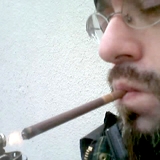So I’ve been thinking.
Somewhere within a few hundred light years of here is where our sun formed around 4.6 billion years ago, and, with it, the rest of our solar system, condensing out of a bit of molecular-cloud-fluff thought to be about 3000 solar masses of largely hydrogen and helium. Probably a large number of stars are siblings to us in the nebula that was our nursery.
It’s been a while, so we’ve all drifted apart a bit since then. And quite a number of our more massive siblings have already snuffed it, as it were.
I carry a lump of iron in my pocket that’s as old as any of the iron we dig out of the ground. It’s a recent arrival, having landed on Earth back in 1947. I’d say it’s about as old as the iron that makes up the planet Mercury. Or the stuff that makes up Earth’s core. The Sun didn’t make it. It’s not old enough or big enough or dead enough. When Sol finally cools down trillions of years from now, it will be a huge oxygen-frosted diamond. That’s as far at it will ever get, fusion-wise. Any iron we have, and any of the elements heavier than iron, came from the super-huge progenitor stars that blew up to make our nursery nebula — or at least salt the huge molecular cloud with all of the heavy elements we grew up with.
So far so good, right?
When huge stars supernova, some of them, anyway — in particular, the ones that fling out chunks of iron and heavier elements like gold and uranium — they do so in a huge explosion that basically turns them inside-out. As part of the process, they eject a core of super-dense neutronium. Or a black hole.
Current theory says there were around ten supernovae salting the nursery with heavy elements, though I’m not really sure what math backs that up. But, given that, that means there are around ten or so neutron stars and/or black holes whizzing around in our local neighborhood (a hundred million to a billion in the Milky Way galaxy in general), slowly evaporating and/or making themselves a menace and/or generally lurking in the dark, biding their time. We can see them as X-ray sources when they’re feeding. But when they’re not?
In the last five to ten million years, the solar system has been traveling through a cavity in the interstellar medium called the Local Bubble — a space cleared out by yet another supernova or two ten to twenty million years ago. The bubble is about 300 light years across, meaning, basically, there’s even less interstellar medium in here with us to eat than usual. About a tenth of Milky Way average.
So what I’m wondering is what the odds are that there is a dark core of one of our parents/progenitors — or possibly a more massive sibling or neighboring cousin with a much shorter lifespan — in here with us in the Local Bubble, stalking along behind us, shadowing us like a monster in the closet or under the bed.
[*]






